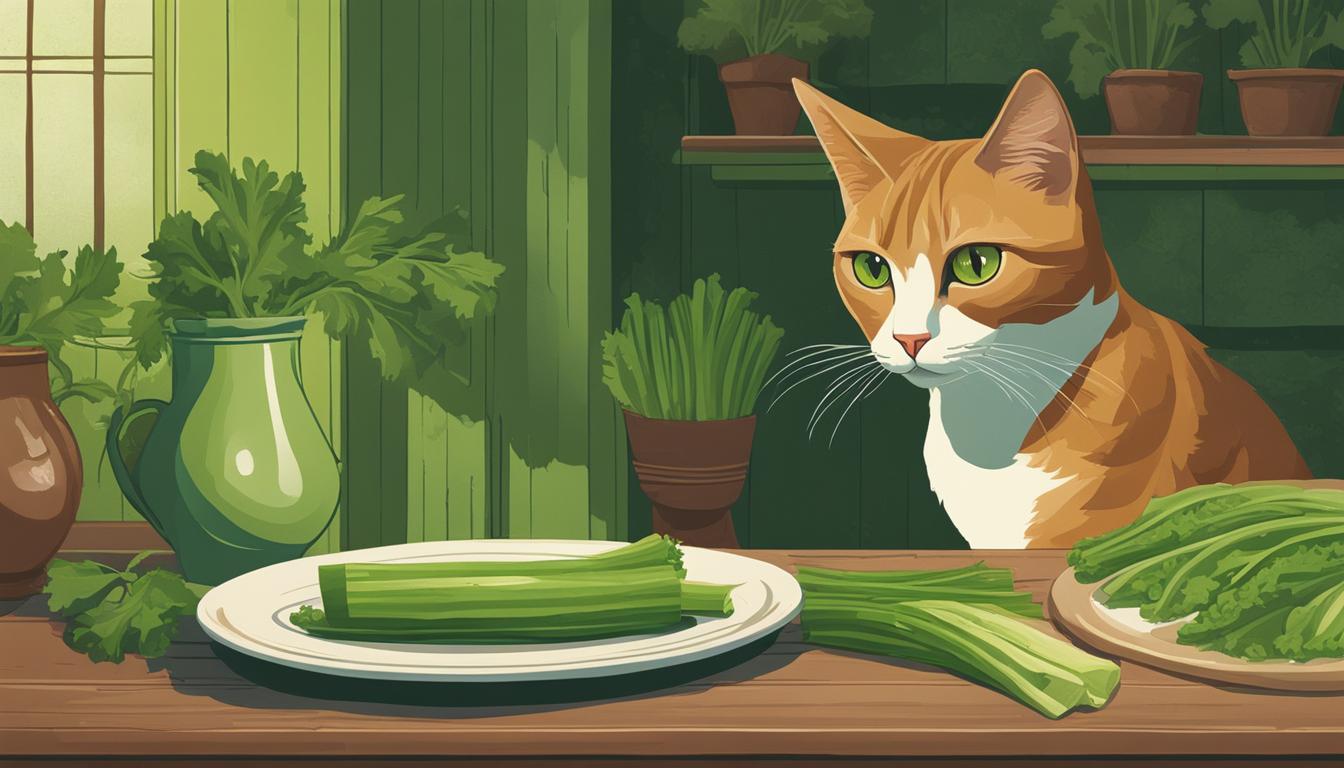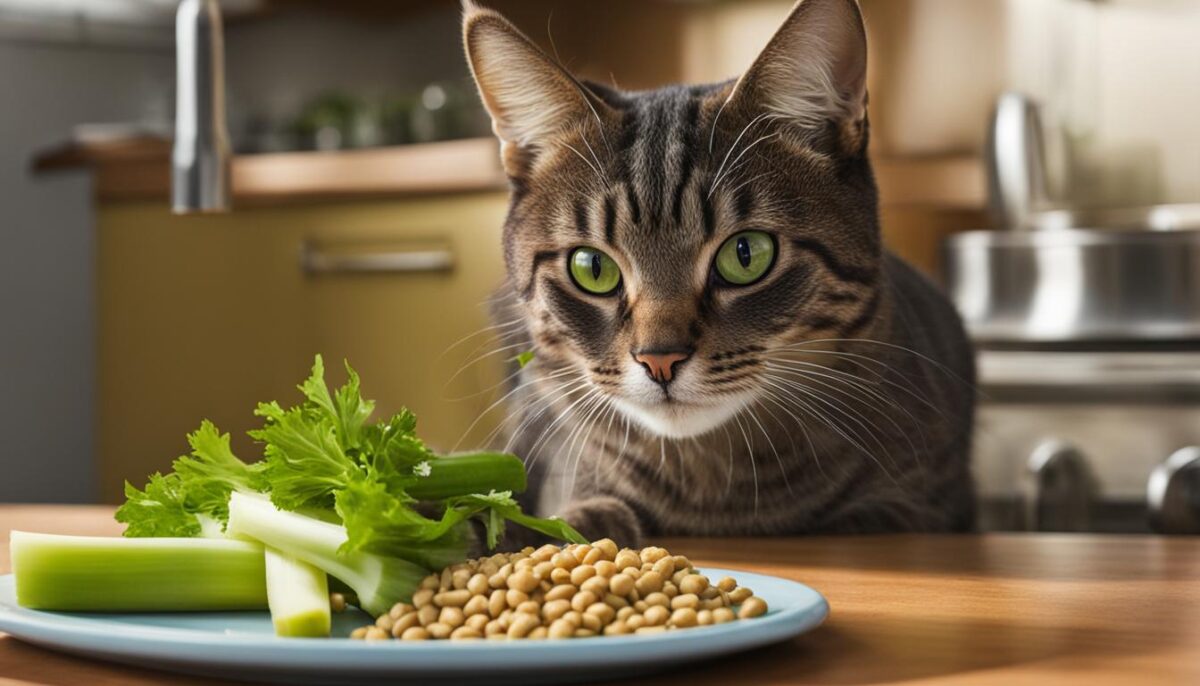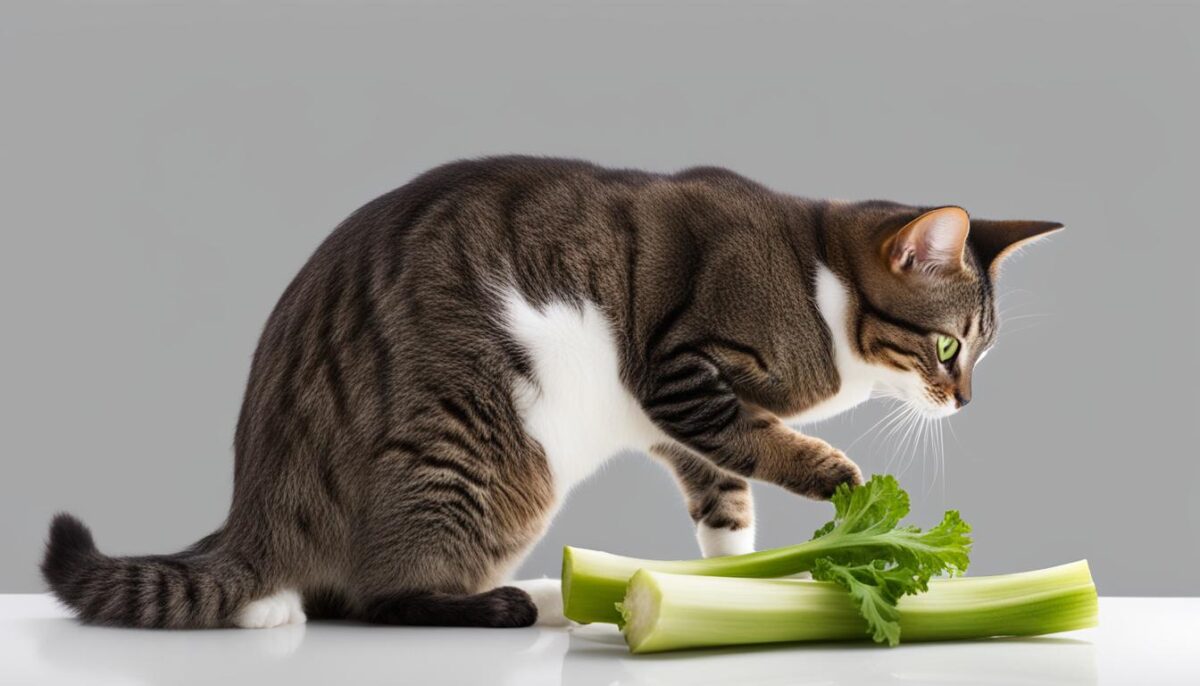Curious if cats can enjoy the crunchy goodness of celery? We’ve got you covered. In this article, we’ll explore whether cats can safely eat celery and provide you with all the information you need to make the best decision for your feline friend.
Key Takeaways:
- Celery can be a safe and healthy addition to a cat’s diet when offered in moderation.
- It is rich in vitamins A, K, and C, as well as folate and potassium.
- Offer celery in small, bite-sized pieces to prevent choking hazards.
- Monitor your cat for any signs of allergies or sensitivities to celery.
- If you notice digestive upset, consult with a veterinarian.
Nutritional Benefits of Celery for Cats
If you’re wondering whether cats can enjoy celery, the answer is yes! Celery can provide some health benefits for our feline friends. While cats are obligate carnivores, meaning their main source of nutrition should come from meat, introducing small amounts of vegetables like celery can offer additional vitamins and minerals to their diet.
One of the main nutritional benefits of celery is its rich vitamin content. Celery is packed with vitamins A, K, and C, which are essential for your cat’s overall health and wellbeing. These vitamins contribute to a strong immune system, healthy vision, and proper blood clotting.
Celery is also a great source of folate and potassium. Folate is crucial for the production of red blood cells, while potassium helps regulate muscle and nerve function. So, adding a bit of celery to your cat’s diet can provide these important nutrients.
“Celery is a low-calorie, fibrous vegetable that can provide some health benefits for cats.”
In addition to vitamins and minerals, celery can also contribute to your cat’s hydration. The high moisture content of celery can help keep your cat hydrated, especially if they don’t drink enough water. This can be particularly beneficial for cats who are prone to urinary tract issues.
However, it’s important to remember that celery should be offered in moderation. While it offers some nutritional benefits, it should not replace your cat’s main source of protein. Too much celery can cause digestive upset in cats, so it’s best to offer it as an occasional treat or mix it in with their regular meals in small amounts.
Table: Nutritional Content of Celery
| Nutrient | Amount per 100g |
|---|---|
| Calories | 16 |
| Carbohydrates | 3.5g |
| Fiber | 1.6g |
| Vitamin A | 449 IU |
| Vitamin K | 29.3 mcg |
| Vitamin C | 3.1 mg |
| Folate | 36 mcg |
| Potassium | 260 mg |
Remember to always wash celery thoroughly before serving it to your cat to remove any pesticides or contaminants. And as with any dietary change, it’s important to monitor your cat’s reaction. If you notice any signs of digestive upset or allergies, it’s best to consult with a veterinarian for further guidance.
Risks and Precautions
When it comes to feeding celery to your cat, there are some risks and precautions that you need to be aware of. While celery can be a healthy addition to a cat’s diet, it should always be given in small, bite-sized pieces to prevent any choking hazards. Cats have a tendency to swallow food quickly, so it’s important to ensure that the celery is cut into manageable pieces that your cat can safely consume.
Additionally, it’s crucial to remove any leaves from the celery before offering it to your cat. The leaves can be difficult for cats to digest and may cause digestive upset. By removing the leaves, you can reduce the risk of any potential digestive issues. Remember, it’s better to be safe than sorry when it comes to your cat’s well-being.
Furthermore, it’s worth noting that some cats may have allergies or sensitivities to celery. Just like humans, cats can have individual reactions to certain foods. Therefore, it’s important to monitor your cat’s reaction after introducing celery to their diet. Look out for any signs of allergies, such as itching, swelling, or difficulty breathing. If you notice any unusual symptoms, it’s best to consult with your veterinarian for further guidance.
In summary, while celery can offer some health benefits to cats, it’s important to take precautions and be mindful of potential risks. Always cut celery into small pieces and remove any leaves before offering it to your cat. Monitor your cat’s reaction for any signs of allergies or sensitivities. By taking these steps, you can ensure that your feline friend can safely enjoy the occasional treat of celery without any adverse effects.
Introducing Celery to Your Cat’s Diet
If you’ve decided to include celery in your cat’s diet, it’s essential to introduce it gradually. Cats can be sensitive to new foods, so it’s important to observe their reactions and ensure their digestive system can tolerate celery.
Start by offering small, bite-sized pieces of celery as a treat. Watch how your cat responds—do they show interest, sniff it, or nibble on it? If your cat enjoys the celery and doesn’t experience any digestive upset, you can gradually incorporate it into their meals.
It’s crucial to ensure the celery is thoroughly washed to remove any pesticides or contaminants. Cut the celery into small, manageable pieces that your cat can easily chew and swallow. Remember to always remove the leaves, as they can be challenging for cats to digest.
Table: Guidelines for Introducing Celery to Your Cat
| Step | Action |
|---|---|
| 1 | Wash the celery thoroughly to remove pesticides and contaminants. |
| 2 | Cut the celery into small, bite-sized pieces. |
| 3 | Offer a small piece as a treat and observe your cat’s reaction. |
| 4 | If your cat shows no signs of digestive upset, gradually incorporate celery into their meals. |
Remember, not all cats will enjoy or tolerate celery. Every cat is unique, and their dietary preferences may vary. If your cat doesn’t show interest in celery or experiences any digestive issues, it’s best to consult with your veterinarian for further guidance.
Alternatives to Celery for Cats
If your cat doesn’t show interest in celery or if you have concerns about its safety, there are plenty of other vegetables that can provide similar nutritional benefits. Here are some cat-friendly alternatives to celery:
- Cooked Carrots: Carrots are a great source of vitamins and fiber for cats. Just make sure to cook them until they are soft and offer them in small, bite-sized pieces.
- Green Beans: Green beans are another nutritious vegetable that cats can enjoy. You can offer them raw or lightly steamed, cut into small pieces.
- Pumpkin: Pumpkin is not only tasty but also beneficial for cats’ digestion. Make sure to use plain, canned pumpkin without any added sugar or spices.
These alternatives can be added to your cat’s diet in moderation, just like celery. Remember to introduce new foods gradually and pay attention to your cat’s reaction. If your cat shows any signs of digestive upset or allergies, consult with your veterinarian for guidance.
Table: Nutritional Comparison of Celery and Alternative Vegetables
| Nutrients | Celery (per 100g) | Carrots (per 100g) | Green Beans (per 100g) | Pumpkin (per 100g) |
|---|---|---|---|---|
| Calories | 16 | 41 | 31 | 26 |
| Fiber (g) | 1.6 | 2.8 | 3.4 | 2.7 |
| Vitamin A (IU) | 449 | 16,706 | 690 | 7,552 |
| Vitamin K (mcg) | 29.3 | 13.2 | 14.4 | 7.1 |
| Vitamin C (mg) | 3.1 | 5.9 | 12.2 | 9.2 |
| Potassium (mg) | 260 | 320 | 211 | 340 |
Note: The nutritional values may vary depending on the specific variety and preparation method of the vegetables.
You can incorporate these alternative vegetables into your cat’s diet to provide variety and ensure they receive a balanced nutritional intake. Remember, always consult with your veterinarian before making any significant changes to your cat’s diet.
Signs of Digestive Upset in Cats
If your beloved feline friend has consumed celery and is experiencing digestive upset, it’s essential to be aware of the signs. Cats can’t speak our language, but their bodies communicate in their own way. Look out for these common symptoms that may indicate digestive discomfort:
- Vomiting
- Diarrhea
- Loss of appetite
- Abdominal discomfort
While these signs can be alarming, it’s important not to panic. Your cat may have a sensitive stomach or react differently to certain foods. Observing these symptoms after feeding celery or any other food allows you to take appropriate action and ensure your furry friend’s well-being.
“Cats can be very sensitive to dietary changes, so it’s important to pay attention to any signs of digestive upset,” advises Dr. Sarah Thompson, a renowned veterinarian.
“If you notice any of these symptoms, it’s best to consult with your veterinarian for further guidance. They can help determine if celery or any other food is causing the issue and provide appropriate treatment.”
Consult with Your Veterinarian
If your cat exhibits any digestive upset after consuming celery, it’s advisable to seek professional advice. Each cat is unique, and a veterinarian can provide personalized guidance based on your pet’s specific needs. They may recommend dietary adjustments, prescribe medications if needed, or conduct further investigations to identify any underlying health conditions.
Always prioritize your cat’s health and well-being. While celery can be a safe and healthy treat for many cats, monitoring their reactions and seeking expert advice when needed is crucial. Remember, your furry friend relies on you for their dietary choices, so it’s essential to make informed decisions and be proactive in caring for their digestive health.
Conclusion
In conclusion, celery can be a safe and healthy addition to your cat’s diet when offered in moderation. It provides some nutritional benefits, including vitamins A, K, and C, as well as folate and potassium. Celery’s high moisture content can also contribute to your cat’s hydration.
However, it is important to consider potential risks and take precautions. Always offer celery in small, bite-sized pieces to prevent choking hazards, and remove any leaves as they can be difficult for cats to digest. Additionally, be mindful of your cat’s individual allergies or sensitivities to celery and monitor their reaction accordingly.
If you decide to introduce celery to your cat’s diet, start slowly by offering small pieces as a treat. Observe how your cat reacts and if there are no signs of digestive upset or adverse reactions, you can incorporate celery into their meals in small amounts.
Remember, every cat is unique, so it’s important to prioritize their individual dietary needs and preferences. If you have any concerns or if your cat shows signs of digestive upset, it’s always best to consult with a veterinarian for personalized advice and guidance.
FAQ
Can cats safely enjoy celery as a part of their diet?
Yes, celery can be a safe and healthy addition to a cat’s diet when offered in moderation.
What are the nutritional benefits of celery for cats?
Celery is rich in vitamins A, K, and C, as well as folate and potassium. It also provides hydration due to its high moisture content.
What are the risks and precautions of feeding cats celery?
Celery should be given in small, bite-sized pieces to prevent choking hazards. It’s important to remove any leaves, as they can be difficult for cats to digest. Some cats may also have allergies or sensitivities to celery, so monitoring their reaction is crucial.
How should I introduce celery to my cat’s diet?
Start by offering small pieces as a treat and observe how your cat reacts. If there are no signs of digestive upset or adverse reactions, you can incorporate celery into their meals gradually.
What are some alternatives to celery for cats?
If your cat doesn’t show interest in celery or if you have concerns about its safety, other cat-friendly alternatives include cooked carrots, green beans, and pumpkin.
What are the signs of digestive upset in cats?
Common symptoms of digestive upset in cats include vomiting, diarrhea, loss of appetite, and abdominal discomfort.


